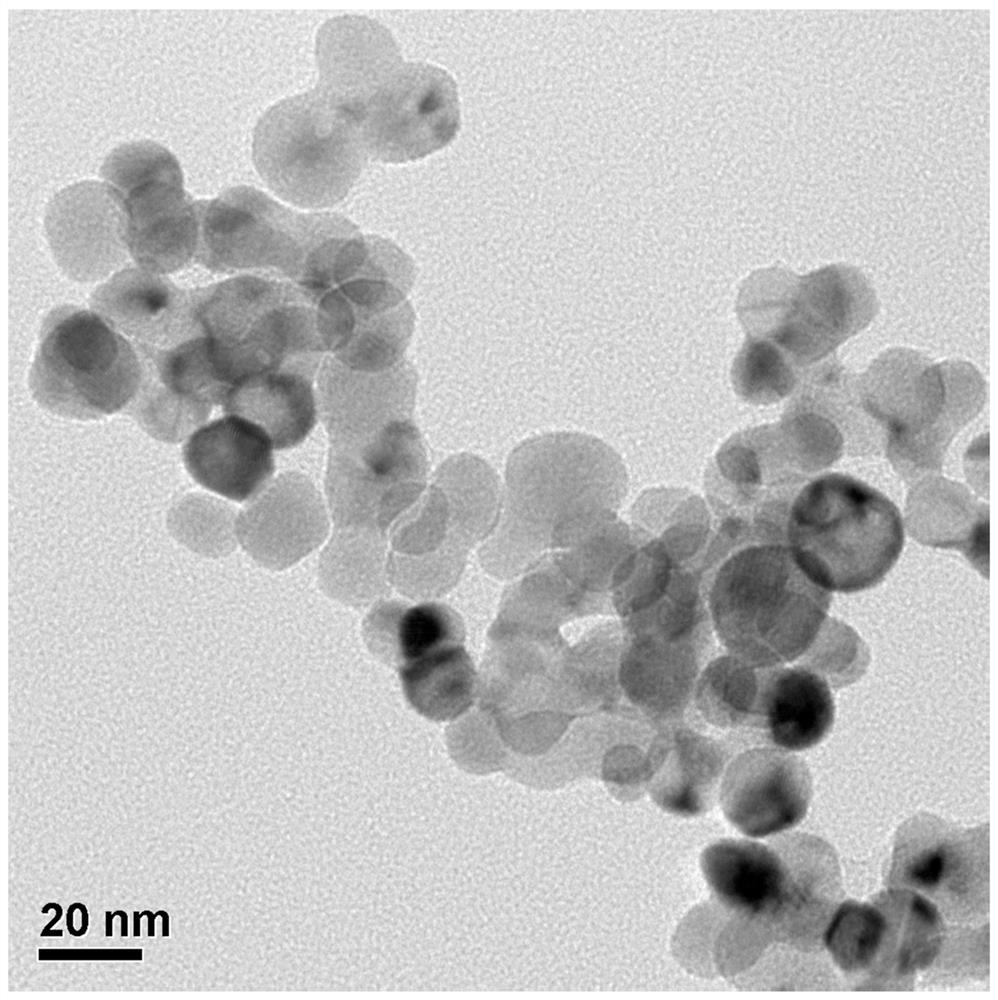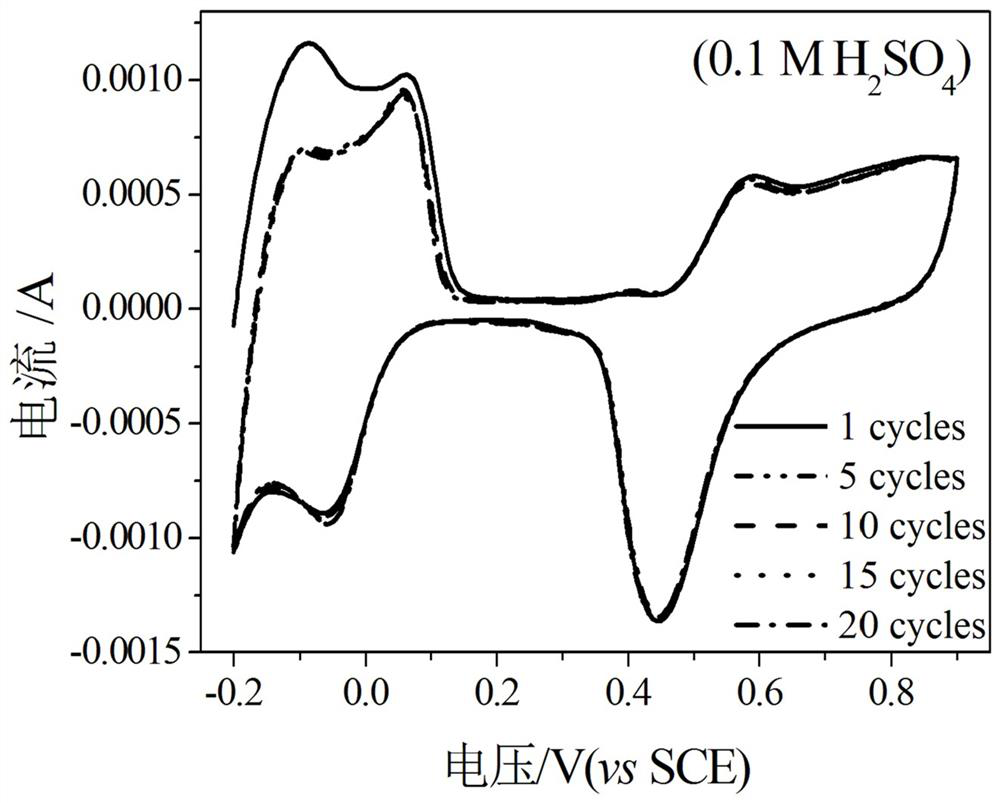Preparation method of electrochemically dealloyed pdcu catalyst for fuel cell
A fuel cell and dealloying technology, which can be used in physical/chemical process catalysts, metal/metal oxide/metal hydroxide catalysts, fuel cells, etc., and can solve the constraints of large-scale commercial application of Pt-based catalysts and fuel cells , poor anti-poisoning ability and catalytic stability, and low Pt reserves, etc., to achieve excellent catalytic oxidation of methanol performance, increase the electrochemical active area, and complete the effect of the reaction.
- Summary
- Abstract
- Description
- Claims
- Application Information
AI Technical Summary
Problems solved by technology
Method used
Image
Examples
Embodiment 1
[0043] (1) Dissolve 0.5 g of P123 in 10 mL of double-distilled water with ultrasonic stirring; add 20 mL of a mixed solution containing 10.53 mg of potassium chloropalladate and 3.58 mg of anhydrous copper chloride to the P123 solution, and mix well by ultrasonic stirring.
[0044] (2) Transfer the mixed solution to the liner of a 50 mL polytetrafluoroethylene reactor, put it into the reactor, place it in a drying oven, and stop the reaction after reacting at 180°C for 12 hours.
[0045] (3) After naturally cooling to room temperature, the reaction solution was centrifuged at 10,000 r / min, washed with twice distilled water and absolute ethanol for 3 to 5 times, then dispersed and stored in absolute ethanol to obtain PdCu catalyst.
[0046] figure 1 Shown is the transmission electron microscope figure of the fuel cell PdCu catalyst prepared by the present embodiment, by figure 1 It can be seen that the catalyst prepared by the one-pot hydrothermal method is a hollow nanospher...
Embodiment 2
[0050] (1) Dissolve 0.5 g of P123 in 10 mL of double-distilled water with ultrasonic stirring; add 20 mL of a mixed solution containing 10.53 mg of potassium chloropalladate and 1.71 mg of anhydrous copper chloride to the P123 solution, and mix well by ultrasonic stirring.
[0051] (2) Transfer the mixed solution to the liner of a 50 mL polytetrafluoroethylene reactor, put it into the reactor, place it in a drying oven, and stop the reaction after reacting at 180°C for 12 hours.
[0052] (3) After naturally cooling to room temperature, the reaction solution was centrifuged at 10,000 r / min, washed with twice distilled water and absolute ethanol for 3 to 5 times, then dispersed and stored in absolute ethanol to obtain PdCu catalyst.
[0053] Figure 4 Shown is the transmission electron microscope figure of the fuel cell PdCu catalyst prepared by the present embodiment, by Figure 4 It can be seen that the catalyst prepared by the one-pot hydrothermal method has a nano-chain st...
Embodiment 3
[0057] (1) Dissolve 0.5 g of P123 in 10 mL of double-distilled water with ultrasonic stirring; add 20 mL of a mixed solution containing 10.53 mg of potassium chloropalladate and 6.77 mg of anhydrous copper chloride to the P123 solution, and mix well by ultrasonic stirring.
[0058] (2) Transfer the mixed solution to the liner of a 50 mL polytetrafluoroethylene reactor, put it into the reactor, place it in a drying oven, and stop the reaction after reacting at 180°C for 12 hours.
[0059] (3) After naturally cooling to room temperature, the reaction solution was centrifuged at 10,000 r / min, washed with twice distilled water and absolute ethanol for 3 to 5 times, then dispersed and stored in absolute ethanol to obtain PdCu catalyst.
[0060] Figure 7 Shown is the transmission electron microscope figure of the fuel cell PdCu catalyst prepared by the present embodiment, by Figure 7 It can be seen that the catalyst prepared by the one-pot hydrothermal method is a nano-chain and...
PUM
| Property | Measurement | Unit |
|---|---|---|
| particle size | aaaaa | aaaaa |
| particle size | aaaaa | aaaaa |
| particle size | aaaaa | aaaaa |
Abstract
Description
Claims
Application Information
 Login to View More
Login to View More - R&D
- Intellectual Property
- Life Sciences
- Materials
- Tech Scout
- Unparalleled Data Quality
- Higher Quality Content
- 60% Fewer Hallucinations
Browse by: Latest US Patents, China's latest patents, Technical Efficacy Thesaurus, Application Domain, Technology Topic, Popular Technical Reports.
© 2025 PatSnap. All rights reserved.Legal|Privacy policy|Modern Slavery Act Transparency Statement|Sitemap|About US| Contact US: help@patsnap.com



